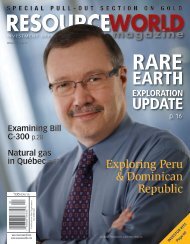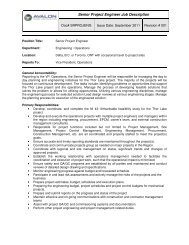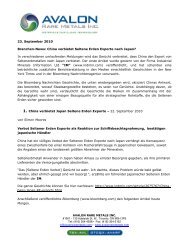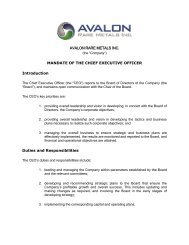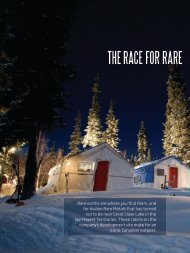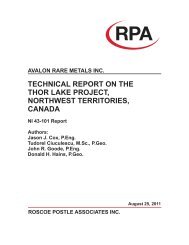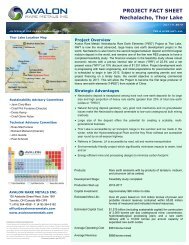technical report on the nechalacho deposit, thor lake project ...
technical report on the nechalacho deposit, thor lake project ...
technical report on the nechalacho deposit, thor lake project ...
Create successful ePaper yourself
Turn your PDF publications into a flip-book with our unique Google optimized e-Paper software.
south of Hearne Channel dem<strong>on</strong>strates that <strong>the</strong> two structures represent extensi<strong>on</strong>al fractures<br />
bordering a basin that was subsequently filled with sedimentary and volcanic rocks.<br />
Later phases of tect<strong>on</strong>ic movement were principally compressi<strong>on</strong>al and relate to closure of <strong>the</strong><br />
rift, over-thrusting, nappe emplacement and recumbent folding in <strong>the</strong> East Arm, and collisi<strong>on</strong> of<br />
<strong>the</strong> Great Bear Magmatic terrain. Younger (Proterozoic) metasedimentary and metavolcanic<br />
rocks south of Thor Lake were <strong>deposit</strong>ed in <strong>the</strong> failed arm of <strong>the</strong> triple juncti<strong>on</strong> rift, and <strong>the</strong>ir<br />
positi<strong>on</strong> now represents <strong>the</strong> locati<strong>on</strong> of this feature.<br />
DIABASE DYKES<br />
Two ages of diabase dyke swarms are present known as <strong>the</strong> Mackenzie and <strong>the</strong> Hearne. The<br />
Mackenzie dykes are dated at 1.27 billi<strong>on</strong> years, have a north-nor<strong>the</strong>ast strike orientati<strong>on</strong> and<br />
are part of <strong>the</strong> largest dyke swarm <strong>on</strong> Earth. Although <strong>the</strong>re are Mackenzie dykes in <strong>the</strong> general<br />
vicinity of Thor Lake n<strong>on</strong>e are known to cut <strong>the</strong> Nechalacho <strong>deposit</strong>.<br />
The Hearne dykes are dated at 1.902by and trend ENE. Diabase dykes locally cut <strong>the</strong><br />
Nechalacho <strong>deposit</strong> and <strong>the</strong>se are interpreted as Hearne-age dykes. At present, <strong>the</strong> dykes are<br />
not well c<strong>on</strong>strained as drill intercepts are infrequent, due to <strong>the</strong> near vertical nature of <strong>the</strong><br />
dykes and <strong>the</strong> mainly vertical drilling. However, in a few cases, vertical drilling has g<strong>on</strong>e down<br />
<strong>the</strong> interior of dykes, and also where <strong>the</strong>re are multiple intercepts, <strong>the</strong> steep nature of <strong>the</strong> dykes<br />
is clear. At present, <strong>the</strong>re is no evidence that <strong>the</strong> Hearne dykes are implaced in fault structures<br />
that have experienced significant displacement. However, this possibility should not be ignored<br />
during <strong>the</strong> explorati<strong>on</strong> program.<br />
STRUCTURE AND TECTONICS<br />
It is interpreted that <strong>the</strong> Nechalacho <strong>deposit</strong> is a virtually undeformed <strong>deposit</strong> where most of <strong>the</strong><br />
features observed were generated by <strong>the</strong> magmatic and hydro<strong>the</strong>rmal processes. In <strong>the</strong> least<br />
altered porti<strong>on</strong>s of <strong>the</strong> <strong>deposit</strong>, delicate primary textures are well preserved and no penetrative<br />
tect<strong>on</strong>ic or metamorphic fabric is observed.<br />
The distributi<strong>on</strong> of most of <strong>the</strong> rock units and <strong>the</strong> mineralizati<strong>on</strong> generally follows a subhoriz<strong>on</strong>tal<br />
pattern that can be traced for several hundreds of metres. However, <strong>the</strong> subhoriz<strong>on</strong>tal<br />
pattern is interpreted to be locally disturbed by changes in elevati<strong>on</strong> of up to 40 m.<br />
These changes in elevati<strong>on</strong> may occur erratically or al<strong>on</strong>g linear trends. As noted above, <strong>the</strong><br />
<strong>deposit</strong> is also cut by late diabase dykes, which are part of <strong>the</strong> ENE trending Hearne dyke<br />
swarm.<br />
Technical Report 43-101 – March 13, 2011 Page 7-5<br />
Prepared by Aval<strong>on</strong> Rare Metals Inc.





